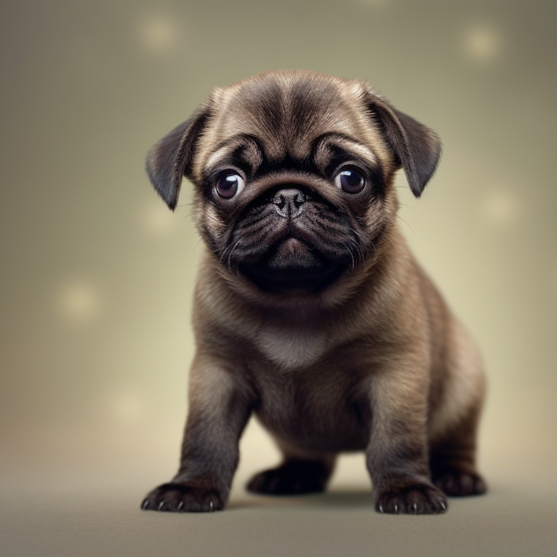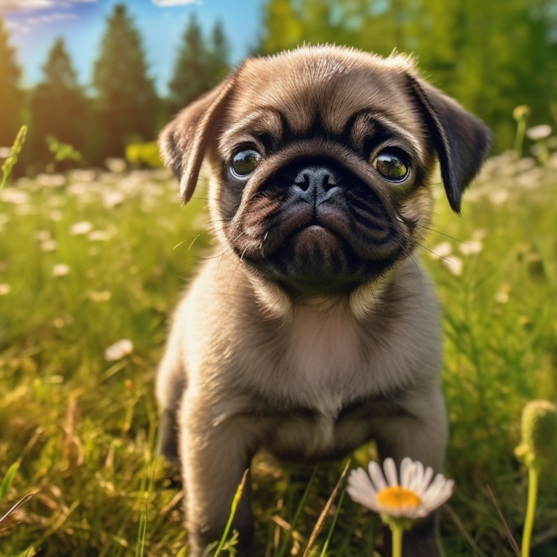Pug Breed Information


Welcome to the delightful world of the Pug breed. These charming little dogs are purebred wonders, known for their spirited and adoring nature. Pugs are a moderate energy breed, making them perfect companions for both active singles and families who enjoy leisurely strolls in the park.
These little dynamos are compact, but don't let their size fool you. Pugs are brave and reliable, always ready to protect their loved ones. They're also regular shedders, so a little fur on your clothes will become a new fashion statement.
When it comes to training, Pugs are determined learners. They love to please their humans and with a little patience, they can learn a variety of commands and tricks. Adult Pugs typically weigh between 14-25 lbs and stand about 10-11 inches tall, making them a comfortable fit for both apartment living and larger homes.
The Pug breed is a bundle of joy wrapped in a small, furry package. Whether you're looking for a Pug puppy or an adult Pug, this breed is sure to bring a smile to your face and warmth to your heart.
Characteristics
- Pugs are known for their adaptability. Whether you live in a bustling city or a quiet countryside, Pugs can adjust and thrive
- These adoring pups love company. They enjoy being around their human family and are also friendly with other pets
- One look into a Pug's large, round eyes, and you'll be smitten. Their eyes are full of expression and add to their overall charm
- A Pug's tail is a work of art. It curls up tightly over their back, giving them a distinctive silhouette
They are small but sturdy, their compact size makes them perfect for cuddles and easy to carry around - Pugs shed regularly, a little brushing can help manage this, and it's a small price to pay for their companionship
- They are determined when it comes to training. Pug dogs are eager to learn and please their humans
- Pugs are a brachycephalic breed, meaning they have a short, broad skull. This gives them their distinctive flat-faced appearance

Appearance
Pugs are a breed that's instantly recognizable and utterly adorable. Their compact, muscular bodies are perfectly proportioned, making them sturdy and agile. Adult Pugs typically weigh between 14-25 lbs and stand about 10-11 inches tall, fitting comfortably in your lap or by your side.
One of the most distinctive features of a Pug's appearance is their beautiful, round eyes. These expressive eyes are dark in color and full of life, often sparkling with mischief or melting your heart with their warmth.
A Pug's face is a masterpiece. Their short, flat nose and deep wrinkles give them an endearing expression that's hard to resist. These wrinkles need regular cleaning to keep your Pug looking her best.
Another unique feature of the Pug breed is their tail. It curls up tightly over their back, adding to their distinctive silhouette. Whether a Pug puppy or an adult Pug, their tail is always a sight to behold.
Pugs have a double coat that sheds regularly. Their coat can be fawn or black, both equally charming. The fawn Pugs have a black mask and ears which contrast beautifully with their light coat.
Temperament
Pugs are known for their friendly and loving temperament. They're brave, adoring, reliable, and spirited, making them wonderful companions. Pugs are social butterflies and love to be the center of attention. They get along well with adults, children, and other pets, making them a great addition to any family.
Pugs are also known for their playful nature. They're always up for a game or a fun training session. Their determined nature makes them eager learners who enjoy pleasing their humans.
Despite their playful side, Pugs also love their downtime. They're quite fond of snuggling up with their favorite human for a nap. Their moderate energy level makes them a great fit for a variety of lifestyles.
Pugs are also known for their loyalty. They form strong bonds with their families and are always ready to protect their loved ones. This, combined with their alert nature, makes them excellent watchdogs.
Whether you're considering a Pug puppy or an adult Pug, their loving and playful temperament is sure to win you over.
Care
Grooming
Pugs are a low-maintenance breed when it comes to grooming, but there are a few things you should know to keep your Pug dog looking their best.
Firstly, Pugs are regular shedders. Their double coat sheds throughout the year, and more so during the shedding seasons of spring and fall. Regular brushing can help manage this shedding and keep your Pugs coat healthy and shiny.
Pugs have distinctive wrinkles on their face. These wrinkles are part of their charm, but they also require regular cleaning. Dirt and moisture can get trapped in these wrinkles, leading to skin issues. A quick daily wipe can keep your Pugs wrinkles clean and their skin healthy.
Their eyes and ears also need regular attention. Their large, expressive eyes should be checked regularly for any signs of irritation or infection. Their ears should be cleaned regularly to prevent any buildup of wax or debris.
Bathing your Pug breed doesn't need to be a frequent affair. A bath every few weeks or when your Pug gets particularly dirty is usually enough. Use a gentle dog shampoo to keep their skin and coat in good condition.
Lastly, don't forget about dental care. Regular brushing of your Pugs teeth can help prevent dental issues and keep their breath fresh.
Exercise Needs
Pugs are a moderate energy breed. They love a good play session, but they're also quite happy to curl up for a nap. Regular exercise is important for a Pug's physical and mental health.
A daily walk is a great way to keep your Pug fit. Pugs love to explore their surroundings, and a walk provides plenty of opportunities for this. Remember, Pugs are brachycephalic, which means they can struggle with intense exercise or heat. Keep walks leisurely and avoid the hottest parts of the day.
In addition to walks, Pugs enjoy playtime. Games of fetch, puzzle toys, or a fun training session can keep your Pug mentally stimulated and physically active.
Despite their exercise needs, Pugs are also quite happy to be couch potatoes. They love to snuggle up with their humans and can be quite the lap dog. Just remember, a balance of exercise and rest is key to keeping your Pug healthy and happy.
Health
Pugs are generally a healthy breed, but like all breeds, they can be prone to certain health conditions. Being aware of these potential issues can help you take the best possible care of your Pug.
One thing to note about Pugs is their brachycephalic nature. This means they have a short, broad skull, which gives them their distinctive flat-faced appearance. This can sometimes lead to breathing difficulties, especially in hot weather or during intense exercise. Regular vet check-ups and avoiding extreme temperatures can help manage this.
Pugs can also be prone to skin issues, often related to their distinctive wrinkles. Regular cleaning of these wrinkles can prevent infections and keep your Pug comfortable.
Eye health is another area to watch in Pugs. Their large, expressive eyes can be prone to certain conditions. Regular checks and cleaning can help prevent issues and ensure your Pugs eyes stay healthy.
It's also important to maintain a healthy weight for your Pug puppy or Pug adult. Due to their love for food, Pugs can be prone to weight gain. Regular exercise and a balanced diet can keep them in good shape.
Lifespan
Pugs are known for their relatively long lifespan. On average, a healthy Pug dog can live between 12-15 years. With good care, regular vet check-ups, and lots of love, your Pug can be a part of your family for many wonderful years.
Training
Training a Pug puppy can be a delightful experience. These dogs are determined learners who are eager to please their humans. Whether you're training a Pug puppy or an adult Pug, their spirited nature and desire to learn make the process enjoyable for both of you.
Pugs are intelligent dogs, and with consistent, positive reinforcement training methods, they can learn a variety of commands and tricks. Remember, Pugs are food lovers, so treats can be a great motivator during training sessions.
House training is an important part of any dog's training, and Pugs are no exception. With patience and consistency, your Pug pup can be house trained successfully. Remember to always reward your Pug for doing the right thing, and never punish them for accidents.
Socialization is another key aspect of training. Pugs are naturally sociable dogs who love to be around people and other pets. Early socialization can help ensure your Pug is comfortable and confident in a variety of situations.
Despite their small size, Pugs can make excellent watchdogs. They're alert and protective of their family, and with the right training, they can learn to alert you to anything unusual.
Remember, every Pug dog is unique, and what works for one might not work for another. It's important to be patient, keep training sessions short and fun, and always end on a positive note. With love and patience, your Pug will be a well-trained, well-behaved member of your family.
History
The history of the Pug breed is as fascinating as the dogs themselves. Originating in China over 2000 years ago, Pugs were treasured by Chinese emperors and lived in luxurious accommodations. They were even guarded by soldiers.
Pugs made their way to Europe in the 16th century through Dutch traders, who were as charmed by these dogs as the Chinese emperors were. The breed quickly became a favorite among European royalty, including Queen Victoria of England, who had a particular fondness for them.
In the 19th century, Pugs were brought to the United States, where they quickly won over hearts. The American Kennel Club recognized the breed in 1885, and since then, the popularity of Pugs has only grown. Today, they're loved worldwide for their charming personalities and adorable looks.

